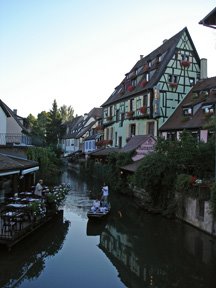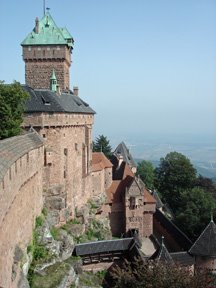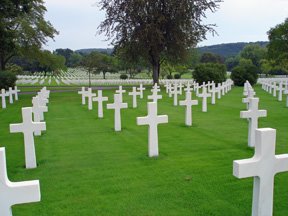 For our first trip to France, we decided to go to the Alsace-Lorraine region. This area borders the north & east sides of the country (near Belgium, Luxembourg, Germany & Switzerland). The region has had a turbulent history, having been caught in most of the skirmishes, and at various times has been considered to be part of the German empire. This sets it somewhat apart from the rest of France, but the result is a friendly and interesting culture. We drove in the evening and spent the next day exploring Metz and Nancy. Then it was on to Colmar, a town on the Alsatian wine road. Alsace produces a great deal of wine, mostly white, and wonderful cremant (sparkling wine). Colmar is a little touristy and the streets look a little more like a german town than what you'd expect to see in France. We settled in to a small cafe for the first of many traditional meals -- the region is famous for its sauerkraut and meat dishes. If you like comfort food then this is the place for you! Here's a shot of the town at night.
For our first trip to France, we decided to go to the Alsace-Lorraine region. This area borders the north & east sides of the country (near Belgium, Luxembourg, Germany & Switzerland). The region has had a turbulent history, having been caught in most of the skirmishes, and at various times has been considered to be part of the German empire. This sets it somewhat apart from the rest of France, but the result is a friendly and interesting culture. We drove in the evening and spent the next day exploring Metz and Nancy. Then it was on to Colmar, a town on the Alsatian wine road. Alsace produces a great deal of wine, mostly white, and wonderful cremant (sparkling wine). Colmar is a little touristy and the streets look a little more like a german town than what you'd expect to see in France. We settled in to a small cafe for the first of many traditional meals -- the region is famous for its sauerkraut and meat dishes. If you like comfort food then this is the place for you! Here's a shot of the town at night.The next day we spent traveling the wine road. It's very different than America -- the wineries are mostly located in the many small medieval villages along the road. We had fun stopping at a few and trying to negotiate the language, which usually started with english, moved to french (Rochelle), then german (Rich), then pointing with our fingers (which sometimes worked best). Here's a shot of Rich in his dream cellar and an idea of the scenery.


 Having been a part of so many conflicts, it's no surprise that there are many castles and ruins throughout the region. We went to Haut-Koenigsburg, which was restored in the early 1900s by Kaiser Wilhelm while the area was under German rule. It is sometimes criticized for being "overly" restored, but it's a spectacular sight nonetheless.
Having been a part of so many conflicts, it's no surprise that there are many castles and ruins throughout the region. We went to Haut-Koenigsburg, which was restored in the early 1900s by Kaiser Wilhelm while the area was under German rule. It is sometimes criticized for being "overly" restored, but it's a spectacular sight nonetheless.We spent 2 nights in Strasbourg, the closest major town, although the city center is so concentrated that it feels smaller than it is.On the way home we happened to see a sign for an American war cemetery. Almost every area in
 Europe has been affected by war at some point or another, and in France there are still many signs of WWI and WWII. We decided to make an unplanned stop and were glad that we did. It turns out that the St. Avold cemetery holds 10,489 American soldiers, the largest number in WWII military cemeteries in Europe. Strangely enough it was a great place to do some "birding," so it turned out to be a beautiful and moving end to our first trip to France.
Europe has been affected by war at some point or another, and in France there are still many signs of WWI and WWII. We decided to make an unplanned stop and were glad that we did. It turns out that the St. Avold cemetery holds 10,489 American soldiers, the largest number in WWII military cemeteries in Europe. Strangely enough it was a great place to do some "birding," so it turned out to be a beautiful and moving end to our first trip to France.














